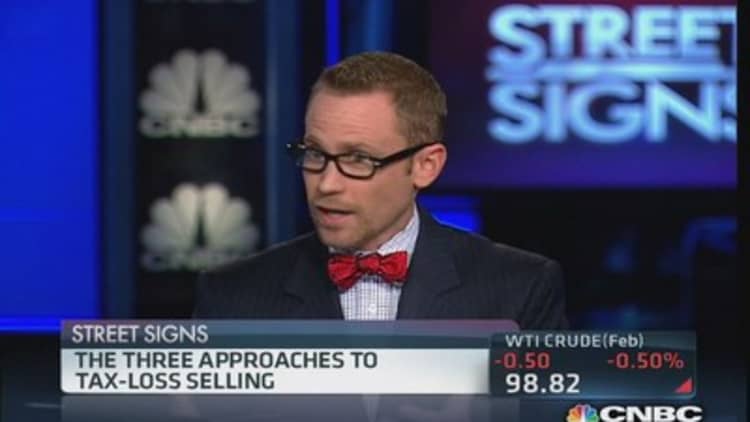It's among the most popular tools available for maximizing after-tax returns. But unbeknownst to many investors, the practice of harvesting losses to offset capital gains also comes with some pretty sizable downside risks.
Some say the benefit of tax-loss harvesting is overstated, that the net effect of selling securities that are down and buying them back really just amounts to a tax deferral for most.
Others maintain that the cumulative effect of harvesting losses year after year can inadvertently subject investors to a higher capital gains rate later on, which negates any savings and then some.
And then there's the risk to your return, the opportunity cost of taking your money off the table when a stock you wish to own is temporarily down.
"Tax-loss harvesting flies in the face of the most fundamental rule of investing, which is buy low and sell high," said Jonathan Citrin, founder and chief compliance officer of CitrinGroup, who nonetheless notes that loss harvesting may make sense for certain investors. "Assets that are down are not necessarily a bad thing."
If it's a stock that provides diversification benefits and balance to your long-term returns, he said, that's the time to buy. "It is such a fundamentally flawed approach—selling important diversifiers in a portfolio for a few bucks saved on taxes," he said. "Investors must think long-term and actually buy into uncorrelated assets that have depreciated during a surging market despite how confident one might be in the continuance of equity growth."
Read MoreBrace for tax-break smackdown
Tax-loss harvesting is most common in the fourth quarter of the year, when investors are scrambling to minimize their tax liability to Uncle Sam.
The Internal Revenue Service allows investors to offset all of their capital gains with losses realized in a given year.
Short- vs. long-term
Generally, long-term losses on securities held for more than a year are netted first against any long-term capital gains, while short-term losses on the sale of securities held for less than a year get applied to short-term gains, which are taxed at your higher ordinary income tax rate. The highest income tax bracket in 2014 is 39.6 percent.
Any additional losses can be deducted up to $3,000 per year against ordinary income, while losses in excess of that limit can be carried forward to future tax years to reduce capital gains or ordinary income until the balance of the losses are used up.
Read More
Most often, tax-loss harvesting is used to limit short-term capital gains.
To generate a loss, investors often sell securities that play an important role in their portfolio but are temporarily down.

Not surprisingly, however, the IRS does not want investors to harvest losses for the sole purpose of minimizing taxes.
Thus, it created the wash-sale rule, which prevents investors from claiming a loss on a security—or a "substantially identical" security—that they repurchase within 30 days before or after the sale.
Read MoreAfter-tax money in a 401(k)? Read this
Investors who tax-loss harvest, then, must wait the required 30 days before repurchasing the security. Most often, they replace it with a corresponding stock or fund during that time.
Therein lies the rub, said Michael Kitces, a certified financial planner with Pinnacle Advisory Group.
Besides the fact that no two securities are exactly alike—you can never truly replace the one you sold with another that performs the same, because if you do, you've broken the law—the stock you bought to "replace" it during the 30-day waiting period may suddenly surge, leaving you with a short-term gain that is bigger than the size of the loss you harvested.
Indeed, that's happening more and more with the growing popularity of online trading and exchange-traded funds, which have cut transaction costs down to size, Kitces said. Investors who purchased a stock for $100 per share, for example, are now more likely to harvest a $2-per-share loss.
Read MoreState, local finances better but not great
"Discount brokers and no-commission ETF trades have really reduced the friction for harvesting losses, which generally is a good thing, but it also means people are trying to harvest smaller losses and risking higher short-term capital gains," Kitces said.
Another potential pitfall of tax-loss harvesting is that over the years, if the losses you lock in are significant enough, you may inadvertently drive up your future tax rate, he said.
Four capital gains rates
How? When you harvest losses and repurchase the stock at the lower price, you also lower your cost basis, or the original cost of the investment. Your cost basis is used to determine your capital gain when you sell the security down the road.
"If I harvest $10,000 in losses every year and I do that for a decade, I created another $100,000 in capital gains that will be subject to tax because I've systematically lowered my cost basis by the same amount," Kitces said. "If the gain is big enough, you will actually drive yourself into the top capital gains rate."
Read MoreKey tips to minimize tax bite
Indeed, for many decades, taxpayers only ever had to contend with two capital gains rates. There was the 0 percent rate for those in the lowest income tax brackets, and a 20 percent rate for everyone else, which was lowered to 15 percent in 2003 before being made permanent for most middle-income taxpayers in 2012.
But now there are four capital gains rates in effect: 0 percent for those in the lowest two brackets, 15 percent for middle-income taxpayers, 18.8 percent for those in the 15 percent bracket who also owe the 3.8 percent Medicare tax, and 23.8 percent for high-income earners who pay the 20 percent capital gains rate plus the 3.8 percent Medicare tax. (Those subject to the 20 percent tax automatically owe the 3.8 percent tax due to their income threshold.)
"That's the big issue so many people miss," Kitces said. "It's a deferral, not a savings.
"You're going to create a gain in the future for the same amount as the loss you just took, and while a deferral has value, it's not nearly as valuable as the full savings," he added. "The savings you have to give back."
Read MoreAdvisors up Social Security smarts
There are a few exceptions to that rule, however.
Martin Durbin, a certified public accountant and financial advisor at Aperture Retirement Designs, said investors can eliminate capital gains on their investment permanently if they opt to donate those shares to charity or pass them along to a loved one after they die.
You can't just look at tax-loss harvesting in a vacuum. You must consider your whole tax picture.Martin Durbincertified public accountant and financial advisor
Your heir would not owe income tax on those shares, and his cost basis would be reset to the fair market trading value on the day he receives them, thanks to what is also known as a "step up in basis."
Taxpayers with unusually high income in a given year, including those who sold a business, received a large bonus or experienced a windfall, are among the candidates for tax-loss harvesting, Citrin said.
Read MoreHow to avoid empty pockets at 80
For many investors, year-end tax planning goes hand in hand with harvesting losses.
Depending upon your income level and the amount of losses you lock in, along with market performance during the wash-sale period, such strategy may amount to a short-term gain, long-term loss.
"You can't just look at tax-loss harvesting in a vacuum," Durbin said. "You must consider your whole tax picture."




